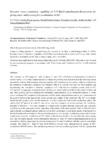Mostrar o rexistro simple do ítem
Receptor versus counterion: capability of N,N′‐Bis(2‐aminobenzyl)‐diazacrowns for giving endo‐ and/or exocyclic coordination of ZnII
| dc.contributor.author | Vaiana, Lea | |
| dc.contributor.author | Platas-Iglesias, Carlos | |
| dc.contributor.author | Esteban-Gómez, David | |
| dc.contributor.author | Avecilla, Fernando | |
| dc.contributor.author | Blas, Andrés de | |
| dc.contributor.author | Rodríguez-Blas, Teresa | |
| dc.date.accessioned | 2020-04-01T11:12:54Z | |
| dc.date.available | 2020-04-01T11:12:54Z | |
| dc.date.issued | 2007-03-20 | |
| dc.identifier.citation | Vaiana, L., Platas‐Iglesias, C., Esteban‐Gómez, D., Avecilla, F., de Blas, A. and Rodríguez‐Blas, T. (2007), Receptor versus Counterion: Capability of N,N′‐Bis(2‐aminobenzyl)‐diazacrowns for Giving Endo‐ and/or Exocyclic Coordination of ZnII. Eur. J. Inorg. Chem., 2007: 1874-1883. | es_ES |
| dc.identifier.issn | 1099-0682 | |
| dc.identifier.uri | http://hdl.handle.net/2183/25284 | |
| dc.description.abstract | [Abstract] The structure of ZnII complexes with receptors L1 and L2[L1 = N,N′‐bis(2‐aminobenzyl)‐1,10‐diaza‐15‐crown‐5 and L2 = N,N′‐bis(2‐aminobenzyl)‐4,13‐diaza‐18‐crown‐6] was studied both in the solid state and in acetonitrile solution. Both receptors form mononuclear ZnII complexes in this solvent, while no evidence for the formation of dinuclear complexes was obtained. This is in contrast with previous investigations that demonstrated the formation of dinuclear complexes of L2 with first‐row transition metals such as NiII, CoII and CuII. Compounds of formula [Zn(L1)](ClO4)2 (1), [Zn(L1)](NO3)2·2CH3CN (2), [Zn(L2)](ClO4)2 (3) and [Zn(L2)(NO3)2] (4) were isolated and structurally characterised by X‐ray diffraction analyses. L1 forms seven‐coordinate ZnII complexes in the presence of both nitrate and perchlorate anions, as a consequence of the good fit between the macrocyclic cavity and the ionic radius of the metal ion. The ZnII ion is deeply buried into the receptor cavity and the anions are forced to remain out of the metal coordination sphere. The cation [Zn(L1)]2+ present in 1 and 2 is one of the very few examples of seven‐coordinate Zn complexes. Receptor L2 provides a very rare example of a macrocyclic receptor allowing endocyclic and exocyclic coordination on the same guest cation, depending on the nature of the anion present. Thus, in 3 the ZnII ion is endocyclically coordinated, placed inside the crown hole coordinated to four donor atoms of the ligand in a distorted tetrahedral environment, whereas in 4, the presence of a strongly coordinating anion such as nitrate results in an exocyclic coordination of ZnII, which is directly bound only to the two primarily amine groups of L2 and two nitrate ligands. Spectrophotometric titrations of [Zn(L2)]2+ with tetrabutylammonium nitrate in acetonitrile solution demonstrate the stepwise formation of 1:1 and 1:2 adducts with this anion in acetonitrile solution. The [Zn(L1)]2+, [Zn(L2)]2+ and [Zn(L2)(NO3)2] systems were characterised by means of DFT calculations (B3LYP model). The calculated geometries show an excellent agreement with the experimental structures obtained from X‐ray diffraction analyses. Calculated binding energies of the macrocyclic ligands to ZnII are also consistent with the experimental data. | es_ES |
| dc.description.sponsorship | Xunta de Galicia; PGIDIT03TAM10301PR | es_ES |
| dc.language.iso | eng | es_ES |
| dc.publisher | Wiley | es_ES |
| dc.relation.uri | https://doi.org/10.1002/ejic.200601012 | es_ES |
| dc.rights | This is the peer reviewed version of the following article: Vaiana, L., Platas‐Iglesias, C., Esteban‐Gómez, D., Avecilla, F., de Blas, A. and Rodríguez‐Blas, T. (2007), Receptor versus Counterion: Capability of N,N′‐Bis(2‐aminobenzyl)‐diazacrowns for Giving Endo‐ and/or Exocyclic Coordination of ZnII. Eur. J. Inorg. Chem., 2007: 1874-1883 which has been published in final form at https://doi.org/10.1002/ejic.200601012. This article may be used for non-commercial purposes in accordance with Wiley Terms and Conditions for Use of Self-Archived Versions. | es_ES |
| dc.subject | Zinc | es_ES |
| dc.subject | Macrocyclic ligands | es_ES |
| dc.subject | Crown compounds | es_ES |
| dc.subject | Coordination modes | es_ES |
| dc.subject | Density functional calculations | es_ES |
| dc.title | Receptor versus counterion: capability of N,N′‐Bis(2‐aminobenzyl)‐diazacrowns for giving endo‐ and/or exocyclic coordination of ZnII | es_ES |
| dc.type | info:eu-repo/semantics/article | es_ES |
| dc.rights.access | info:eu-repo/semantics/openAccess | es_ES |
| UDC.journalTitle | European Journal of Inorganic Chemistry | es_ES |
| UDC.volume | 2007 | es_ES |
| UDC.issue | 13 | es_ES |
| UDC.startPage | 1874 | es_ES |
| UDC.endPage | 1883 | es_ES |
Ficheiros no ítem
Este ítem aparece na(s) seguinte(s) colección(s)
-
GI-REACT! - Artigos [103]






